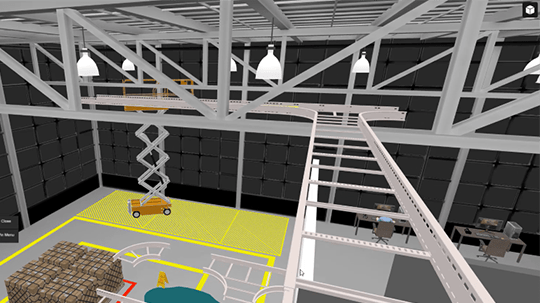Introduction
In the rapidly evolving aerospace industry, the ability to visualize, assess, and refine complex designs is crucial for successful product development. iQ3Connect’s immersive collaboration platform is redefining how aerospace companies approach design validation, stakeholder engagement, and maintenance planning. By leveraging virtual reality (VR), iQ3Connect enables teams to simulate and interact with 3D models, effectively bridging the gap between concept and reality.
A leading aerospace development organization, known for its commitment to innovation and precision engineering, has been actively involved in the design and development of multi-configuration aircraft. To maintain their competitive edge, they sought to streamline product walkthroughs, cockpit assessments, and maintenance evaluations — processes that were traditionally reliant on physical prototypes and static CAD models. This shift toward immersive virtual prototyping helped to reduce design cycle times, minimize costs, and enhance stakeholder engagement.
Background
Before adopting iQ3Connect’s virtual prototyping capabilities, the aerospace development company relied on conventional methods for product walkthroughs, cockpit assessments, and maintenance evaluations. These manual processes involved:
- Building physical prototypes to showcase multiple aircraft configurations, leading to excessive material costs and extended lead times
- Utilizing static CAD models and 2D drawings, limit interactive exploration and spatial 1:1 scale understanding
- Repeated trial-and-error adjustments in cockpit design, consuming time and resources
- Constructing physical mock-ups for maintenance access assessments, delaying design validation and increasing costs.
Challenges
- Inconsistent Feedback: Traditional design methods made it challenging to gather comprehensive, real-time feedback from pilots, engineers, and stakeholders, resulting in miscommunication and potential design flaws.
- Limited Visibility: Static CAD models did not accurately convey spatial arrangements, leading to overlooked ergonomic and accessibility issues.
- High Costs and Time Delays: Developing multiple physical prototypes for different configurations significantly escalated project costs and extended timelines.
- Inefficient Iteration: Design revisions required extensive physical rework, hindering the ability to make rapid adjustments based on stakeholder feedback.
Enhanced Benefit of iQ3Connect
The aerospace development company leveraged iQ3Connect to enhance their product development process across multiple areas, resulting in significant operational and cost efficiencies. By integrating VR into their workflow, they achieved the following:
- Product Walkthroughs:
- Multi-Configuration Showcases: The company utilized iQ3Connect to load multiple CAD-based cabin configurations — from civilian aircraft to Medivac variants — within a single VR workspace, allowing stakeholders to switch between configurations seamlessly.
- Real-Time Exploration: Stakeholders could virtually walk through aircraft cabins, assessing seating arrangements, cabin space utilization, and passenger comfort without the need for physical prototypes.
- Interactive Visualization: Users could zoom in, rotate, and inspect intricate details like seat placements, emergency exits, and storage compartments, facilitating a more comprehensive understanding of the design.
- Enhanced Decision-Making: The VR walkthroughs provided a more immersive experience, helping stakeholders identify potential design flaws early and make informed decisions without extensive physical rework.
- Cockpit Design Evaluation:
- Realistic Pilot Simulation: The cockpit design assessments in iQ3 involved multiple evaluation sessions with both Air Force and civilian pilots, replicating the operational environment in VR.
- Ergonomic Analysis: By aligning the pilot’s vision to a designated ‘eye point,’ pilots could assess control reachability, spatial arrangement, and visibility, allowing for precise adjustments to control placements.
- Rapid Iterations: The VR platform allowed the design team to implement pilot feedback immediately, making multiple design iterations essentially free without constructing new physical mock-ups.
- User Experience Testing: Pilots experienced the cockpit layout in VR, identifying discomfort points, visibility issues, and potential obstructions, resulting in refinements that would otherwise require extensive physical rework.
- Maintenance Evaluations:
- Comprehensive Maintenance Reviews: The service engineering teams used iQ3 to conduct virtual assessments of maintenance access points, tool access, and component placements.
- Detailed Feedback Integration: Maintenance personnel could virtually explore engine bays, control panels, and service points to identify potential access challenges and suggest design modifications.
- Reduction in Physical Mock-ups: By resolving more than of the identified maintenance issues directly in the VR environment, the company minimized the need for costly physical prototypes.
- Real-Time Collaboration: Maintenance engineers, designers, and stakeholders could collaborate in a shared VR space, discussing potential modifications and validating service procedures in real time.
Summary
iQ3Connect’s immersive platform has emerged as a game-changing tool in aerospace development, enabling the company to bridge the gap between conceptual design and practical application. By integrating VR into the workflow, the company has:
- Enhanced design accuracy and stakeholder engagement
- Reduced costs associated with physical prototypes and rework
- Accelerated project timelines by streamlining the feedback loop
Ultimately, iQ3Connect empowers aerospace teams to innovate faster, reduce costs, and deliver higher-quality products with greater confidence and efficiency.
Beyond aerospace, industries such as automotive manufacturing, construction, industrial equipment design, and power generation can also leverage iQ3’s capabilities for interactive prototyping, maintenance training, and spatial assessments, further extending its impact across various sectors.

















